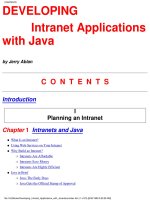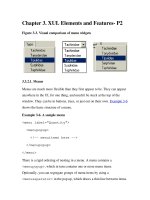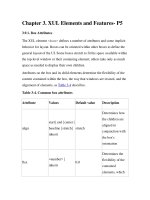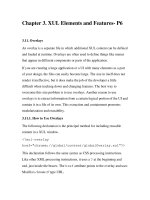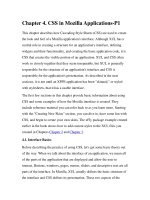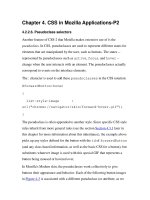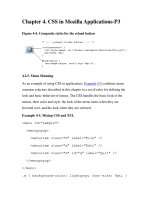Cloning internet applications with ruby
Bạn đang xem bản rút gọn của tài liệu. Xem và tải ngay bản đầy đủ của tài liệu tại đây (7.44 MB, 336 trang )
Cloning Internet Applications
with Ruby
Make your own TinyURL, Twitter, Flickr, or Facebook
using Ruby
Chang Sau Sheong
BIRMINGHAM - MUMBAI
Cloning Internet Applications with Ruby
Copyright © 2010 Packt Publishing
All rights reserved. No part of this book may be reproduced, stored in a retrieval
system, or transmitted in any form or by any means, without the prior written
permission of the publisher, except in the case of brief quotations embedded in
critical articles or reviews.
Every effort has been made in the preparation of this book to ensure the accuracy
of the information presented. However, the information contained in this book is
sold without warranty, either express or implied. Neither the author, nor Packt
Publishing, and its dealers and distributors will be held liable for any damages
caused or alleged to be caused directly or indirectly by this book.
Packt Publishing has endeavored to provide trademark information about all of the
companies and products mentioned in this book by the appropriate use of capitals.
However, Packt Publishing cannot guarantee the accuracy of this information.
First published: August 2010
Production Reference: 1110810
Published by Packt Publishing Ltd.
32 Lincoln Road
Olton
Birmingham, B27 6PA, UK.
ISBN 978-1-849511-06-3
www.packtpub.com
Cover Image by Asher Wishkerman ()
Credits
Author
Chang Sau Sheong
Reviewer
Warren Brian Noronha
Editorial Team Leader
Aanchal Kumar
Project Team Leader
Lata Basantani
Francisco
Project Coordinator
Acquisition Editor
Jovita Pinto
Douglas Paterson
Proofreader
Development Editor
Aaron Nash
Chaitanya Apte
Graphics
Technical Editors
Geetanjali Sawant
Alfred John
Kartikey Pandey
Indexer
Hemangini Bari
Production Coordinator
Arvindkumar Gupta
Cover Work
Arvindkumar Gupta
About the Author
Chang Sau Sheong has more than 15 years experience in software application
development and has spent much of his career working on Web and Internet-based
applications. He started up elipva, an e-business software company, and was the
Vice President of Product Engineering as well as Chief Architect. Subsequently he
was Director of Software Development for Welcome Real-time, a bank loyalty
software company, Engineering Director for Yahoo! Southeast Asia and Chief
Technology Officer for Garena Online, an online game publishing company. He is
currently the Director of the Applied Cloud Computing Lab in HP Labs Singapore,
the research arm of Hewlett Packard, leading a team of engineers to implement
cloud computing solutions.
Sau Sheong frequently writes for technical magazines and journals, including Java
Report, Java World, and Dr. Dobb’s Journal. He is a passionate programmer who
contributes to open source projects in various technologies including Ruby and Java.
He has a wide range of experience in web application development on the Internet
and mobile devices. His first book was ‘Ruby on Rails Mashup Projects’ in 2008, also
published by Packt Publishing.
Sau Sheong hails from tropical Malaysia but spent most of his adult and working
life in sunny Singapore, where he shares his spare time between enthusiastically
writing software and equally enthusiastically playing Nintendo Wii with his wife
and son. He has a Bachelors degree in Computer Engineering, a Masters degree in
Commercial Law, and is a certified international arbitrator.
Acknowledgement
Firstly, many thanks to Douglas Paterson who agreed to this second book project,
the book reviewers who have helped me improve my sprawling book and Jovita, the
patient project coordinator who would wait patiently and gently prompt me as my
chapter deadline approaches. I would also like to thank my Twitter and Hackerspace
friends who on many occasions had to endure my relentless requests to test my
‘clones’ and provide feedback on them. A big thank you to Philippe Monnet who
helped to review the first few chapters and even offered to re-draw a diagram for
me. Final thanks to the love of my life, Wooi Ying, who suffered my erratic ‘nightlife’
in huddling in front of my laptop, creating software and writing yet another book
(with her eyes rolling), and then there is Kai Wen who understands Daddy is finally
an author.
About the Reviewers
Warren Noronha is an entrepreneur and a geek. Computers have been part
of Warren’s life since he was four years old. He began his career as a system
administrator, but ended up doing everything from security, design, to product
development. He enjoys managing people as much as he does managing code or
machines. Having worked with small startups as well as Fortune 500 companies,
Warren is also a staunch supporter of free software and free speech. He has been a
frequent speaker at various colleges and events, discussing subjects ranging from
technology and media to launching a startup.
Warren loves working with new technologies, a trait which lead him to become one
of the first users of GNU/Linux, Drupal, and Ruby on Rails, much before they grew
exponentially and became mainstream technologies. He spends his time working
on databases, distributed computing, and social computing, and enjoys using the
Internet and communication technology to bridge the digital divide.
Francisco started out as a software architect and a project manager for various
desktop and web applications. Then after falling out of love with outdated
technologies and processes switched over to system admin and server infrastructure
expert. Ruby was the catalyst to bring him back to the software development with
agile processes. Currently a Mac lover and Ruby all in one backend expert. His
experience in the server provisioning world and background as software developer
resulted in quick rollout of fast, secure, and reliable backend Ruby on Rails
applications for the enterprise.
Table of Contents
Preface1
Chapter 1: Cloning Internet Applications
7
Who would find this book useful
8
Popular Internet applications
9
Technologies used
10
Sinatra10
Installing11
Routes11
Splitting a route into multiple files
12
Redirection13
Filters13
Static pages
14
Views14
Layouts14
Helpers15
Error handling
15
DataMapper16
Installing17
Connecting to the database
17
Creating models
17
Defining associations between models
19
Creating the database tables
26
Finding records
26
Haml
Installing
Using Haml
Haml and Ruby
27
27
27
28
How this book works
29
Caveat30
Summary30
Table of Contents
Chapter 2: URL Shorteners – Cloning TinyURL
All about URL shorteners
Main features
Designing the clone
Creating a short URL for each long URL
Automatically redirecting from a short URL to a long URL
Providing a customized short URL
Filtering undesirable words out
Previewing the long URL
Providing statistics
31
31
35
36
36
37
38
38
38
39
Technologies and platforms used
39
Sinatra40
Haml40
DataMapper40
Blueprint CSS
40
Mashups40
Google Chart API
41
HostIP41
Heroku41
Building the clone
41
Data model
42
Url
42
Link43
Visit44
Application flow
47
Deploying the clone
52
Summary56
Chapter 3: Microblogs – Cloning Twitter
57
All about microblogs
57
Twitter60
Why Twitter?
Main features
Designing the clone
Posting statuses
Following users
Sending publicly directed messages
Sending privately directed messages
Re-tweeting
Public timeline
API
[ ii ]
61
65
65
66
66
68
68
69
69
69
Table of Contents
Authentication, access control, and user management
Third party authentication and access control
Authentication and user management
70
71
72
Scalability and stability
74
Technologies and platforms used
75
JSON75
Mashups76
RPX76
Google ClientLogin
78
Gravatar
79
TinyURL
80
Heroku
Building the clone
Modeling the data
80
80
80
User
Status
81
85
Building the application flow
90
Authenticating and managing users
Displaying and updating statuses
Sending and displaying direct messages
Showing and forming relationships
91
96
106
109
Implementing the API
111
Deploying the clone
115
Deploying locally
115
Deploying to the cloud
116
Summary119
Chapter 4: Photo Sharing – Cloning Flickr
All about photo-sharing services
Flickr
Main features
Designing the clone
Authentication, access control, and user management
Albums and photos
Uploading and storing photos
Comments
Annotations
Editing photos
Friendly URLs
Sharing photos
Technologies and platforms used
Mashups
121
121
123
124
124
124
125
125
127
128
128
128
128
129
129
RPX130
Gravatar130
[ iii ]
Table of Contents
Pixlr130
Amazon Web Services Simple Storage Service (S3)
131
RightAWS133
Building the clone
133
Configuration
133
Modeling the data
134
User135
Album
138
Photo
139
Annotation146
Comment146
Building the application flow
147
Authenticating and managing users
Landing page
Managing albums
Uploading photos
Displaying photos
Annotating photos
Commenting on photos
Editing photos
Sharing photos
147
152
157
167
169
179
184
185
188
Deploying the clone
193
Deploying on a server
193
Summary194
Chapter 5: Social Networking Services – Cloning Facebook 1
All about social networking services
Main features
User
Community
Content sharing
Designing the clone
Authentication, access control, and user management
Status updates
User activity feeds and news feeds
Friends list and inviting users to join
Posting to the wall
Sending messages
Attending events
Forming groups
Commenting on and liking content
[ iv ]
195
195
197
198
199
199
200
200
200
201
201
202
202
203
203
204
204
Table of Contents
Sharing photos
Blogging with pages
Technologies and platforms used
Mashups
205
205
205
205
Building the clone
Configuring the clone
Modeling the data
206
206
206
Summary
225
Facebook Connect
206
User
Request
Message
Album
Photo
Status
Group
Event
Page
Wall
Activity
Comment
Like
207
212
212
213
213
217
219
220
222
223
224
224
225
Chapter 6: Social Networking Services – Cloning Facebook 2
Building the application flow
Structure of the application and flow
Authenticating and managing users
Landing page, news feed, and statuses
Inviting friends and friends list
Registering a Facebook application
Creating a cross-domain communication channel file
Writing the code
227
227
227
230
234
240
248
249
249
User page and activity feeds
Posting to a wall
Sharing photos
253
255
259
Sending messages
Creating events
Forming groups
Sharing content through pages
277
284
294
301
Managing albums
Uploading photos
Displaying photos
Annotating photos
Viewing friends' photos
259
265
267
273
277
[v]
Table of Contents
Commenting and liking
Deploying the clone
Deploying locally
Deploying to the cloud
Summary
307
310
310
311
312
Index313
[ vi ]
Preface
We stand on the shoulders of giants. This has been true since the time of Newton
(and even before) and it is certainly true now. Much of what we know and learn of
programming, we learnt from the pioneering programmers before us and what we
leave behind to future generations of programmers is our hard-earned experience
and precious knowledge. This book is all about being the scaffolding upon which
the next generation of programmers stands when they build the next Sistine Chapel
of software.
There are many ways that we can build this scaffolding but one of the best ways
is simply to copy from what works. Many programming books attempt to teach
with code samples that the readers can reproduce and try it out themselves. This
book goes beyond code samples. The reader doesn’t only copy snippets of code or
build simple applications but have a chance to take a peek at how a few of the most
popular Internet applications today can possibly be built. We explore how these
applications are coded and also the rationale behind the way they are designed. The
aim is to guide the programmer through the steps of building clones of the various
popular Internet applications.
What this book covers
Chapter 1, Cloning Internet Applications gives a brief description of the purpose of
the book, the target readers of the book, and a list of the four popular Internet
applications we will be cloning in the subsequent chapters. The bulk of this chapter
gives a brief run-down on the various technologies we will be using to build
those clones.
Chapter 2, URL Shorteners – Cloning TinyURL explains about the first popular Internet
application that we investigate and clone in the book, which is TinyURL. This
chapter describes how to create a TinyURL clone, its basic principles, and
algorithms used.
Preface
Chapter 3, Microblogs – Cloning Twitter. The clone in this chapter emulates one of
the hottest and most popular Internet web applications now—Twitter. It describes
the basic principles of a microblogging application and explains how to recreate a
feature-complete Twitter clone.
Chapter 4, Photo -sharing – Cloning Flickr. Flickr is one of the most popular and
enduring photo-sharing applications on the Internet. This chapter describes how the
reader can re-create a feature complete photo-sharing application the simplest way
possible, following the interface and style in Flickr.
Chapter 5, Social Networking Services – Cloning Facebook 1. The final two chapters
describe the various aspects of Internet social networking services, focusing on one
of the most popular out there now—Facebook. These two chapters also describe
the minimal features of a social networking service and show the reader how to
implement these features in a complete step-by-step guide. The first part is described
in this chapter, which sets the groundwork for the clone and proceeds to describe the
data model used in the clone.
Chapter 6, Social Networking Services – Cloning Facebook 2. The final chapter is part two
in describing how to create a Facebook clone. This chapter follows on the previous
chapter and describes the application flow of the Facebook clone we
started earlier.
What you need for this book
Basic Ruby programming skills and basic level operational knowledge of Sinatra,
DataMapper, Haml, Blueprint CSS, and MySQL.
Who this book is for
This book is written for web application programmers with an intermediate
knowledge of Ruby. The reader should also know how web applications work and
have used at least some of the cloned Internet services before.
A typical reader would be a programmer looking to write their own customized
TinyURL, Twitter, Flickr, or Facebook. Programmers who want to include features
of these Internet services into their own web applications will also find this
book interesting.
[2]
Preface
Conventions
In this book, you will find a number of styles of text that distinguish between
different kinds of information. Here are some examples of these styles, and an
explanation of their meaning.
Code words in text are shown as follows: “The many-to-many association can be
defined with the has n and belongs_to methods.”
A block of code is set as follows:
after :create, :create_wall
def create_wall
self.wall = Wall.create
self.save
end
Any command-line input or output is written as follows:
$ sudo gem install Haml
New terms and important words are shown in bold. Words that you see on the
screen, in menus or dialog boxes for example, appear in the text like this: “The one
big difference is of course, the list of statuses belongs to only that user, and there is a
big follow button for the viewing user to follow him.”
Warnings or important notes appear in a box like this.
Tips and tricks appear like this.
Reader feedback
Feedback from our readers is always welcome. Let us know what you think about
this book—what you liked or may have disliked. Reader feedback is important for us
to develop titles that you really get the most out of.
To send us general feedback, simply send an e-mail to ,
and mention the book title via the subject of your message.
[3]
Preface
If there is a book that you need and would like to see us publish, please send us a
note in the SUGGEST A TITLE form on www.packtpub.com or e-mail suggest@
packtpub.com.
If there is a topic that you have expertise in and you are interested in either writing
or contributing to a book on, see our author guide on www.packtpub.com/authors.
Customer support
Now that you are the proud owner of a Packt book, we have a number of things to
help you to get the most from your purchase.
Downloading the example code for this book
You can download the example code files for all Packt books you have
purchased from your account at . If you
purchased this book elsewhere, you can visit ktPub.
com/support and register to have the files e-mailed directly to you.
Errata
Although we have taken every care to ensure the accuracy of our content, mistakes
do happen. If you find a mistake in one of our books—maybe a mistake in the text or
the code—we would be grateful if you would report this to us. By doing so, you can
save other readers from frustration and help us improve subsequent versions of this
book. If you find any errata, please report them by visiting ktpub.
com/support, selecting your book, clicking on the errata submission form link, and
entering the details of your errata. Once your errata are verified, your submission
will be accepted and the errata will be uploaded on our website, or added to any list
of existing errata, under the Errata section of that title. Any existing errata can be
viewed by selecting your title from />
Piracy
Piracy of copyright material on the Internet is an ongoing problem across all media.
At Packt, we take the protection of our copyright and licenses very seriously. If you
come across any illegal copies of our works, in any form, on the Internet, please
provide us with the location address or website name immediately so that we can
pursue a remedy.
[4]
Preface
Please contact us at with a link to the suspected
pirated material.
We appreciate your help in protecting our authors, and our ability to bring you
valuable content.
Questions
You can contact us at if you are having a problem with
any aspect of the book, and we will do our best to address it.
[5]
Cloning Internet Applications
This book is about copying. Copying has an unpleasant reputation in these copyright
and intellectual property sensitive times, but it's probably unknown to many, that it
has an illustrious past. When we were babies, the main way we learnt was through
copying what our parents did. If you have young children you soon learn to your
regret the first time you utter any insalubrious words and how quickly your child
copies your exclamation and mannerisms. Our number system was copied from
the Arabs (that's why they are called Arabic numerals) but it was first used by the
Indians from the Indian subcontinent, and subsequently copied by the Arabs in the
Middle-East. The English language regularly copies words from other languages. In
fact the word 'copy' comes from the Old French word copie which comes from the
Medieval Latin word copia.
That is not to say infringing copyright is the right thing to do when someone else
has spent tremendous effort in coming up with the original. However, it should be
recognized that not all things are copyrightable, patentable, or can be trademarked,
and that is for a good reason. Ideas for example are generally not considered as
intellectual property. Copyright is the protection of expressions of ideas, not the
protection of the ideas themselves. Patent law is used for the protection of inventions
for a limited time in return for the disclosure of the invention. Again it is not a
protection of ideas; the concept of patent law is to promote the liberation of the idea
in exchange for limited monopoly. Google is well known to have dominance in the
search engine market but it doesn't mean it has monopoly on search engines. Anyone
else is free to write his/her own search engine (though taking part of Google's search
engine code to write your own search engine is copyright infringement).
This idea of copying is the basis of the book you are holding. In short, the premise
of this book is to learn how each of the popular Internet applications we clone work
through copying the ideas behind them.
Cloning Internet Applications
In this chapter we will cover:
•
A brief description of the type of people who would like to read this book
•
The popular Internet applications described in this book and why we
chose them
•
The various technologies used in this book, including Sinatra, DataMapper,
and Haml
Who would find this book useful
The primary audience for this book are Ruby programmers with an intermediate
level of experience in Ruby as well as web application programming. This sounds
quite limiting but in reality if you have any intermediate level of programming in
any object-oriented language you should be able to follow the implementations with
relative ease. Of course, if you know something about the Ruby programming language it helps a lot too.
The technology stack that we will be using for these clones is slightly off the usual
track for the Ruby on Rails crowd. The main reason is because it's a simpler stack
to use. Ruby on Rails, while extremely easy to use and very powerful, has a lot of
added frills to the framework, which adds on unnecessary complexity for a book that
focuses on clones and features of the clones only. The chosen stack however does not
different too greatly for programmers who are familiar with Rails. In this chapter we
will go through all that is needed to follow the rest of the chapters in this book.
So why are we interested in cloning these applications at all, since we can't possibly
build a clone that is better than the original? There are plenty of reasons for doing so
but let me just give four common ones:
1. To learn how these applications work. We use them all the time and
while we would know how these applications functionally work, cloning
them will teach us how these features can be implemented. Although the
implementation is not definitive, at least learning how difficult or easy it is
to clone them gives us a better appreciation of how things work behind the
scenes to provide us with the features.
2. To incorporate features of the clones into your own application. As you will
see in this book, each chapter shows how key features in those applications
are implemented. If you want to build these key features into your own
application, learning how these features are implemented will give you an
insight into building them for your own use.
[8]
Chapter 1
3. To build a customized clone. While each popular Internet application has
plenty of features to go with, there will be special niche needs that can only
be fulfilled by a customized version of that application.
4. Learning the technology stack. The best way to learn any new technology
stack is to build something with it. Going through the chapters in this book
will give you ample exercise in this stack.
If you find yourself having any of the above needs then this book is for you.
Popular Internet applications
Why did we choose the Internet applications in this book and not others? Firstly
and most obviously, the applications must be popular and have a large number of
users. Secondly the application should be a mainstream one for consumers and not
for businesses. We want applications that have a more direct interface to the final
consumers of the application. Thirdly, we don't want to deal with payment related
issues in this book so any e-commerce applications are left alone. The reason is
simple—e-commerce is no longer rocket science but implementing payment well is
still not a trivial undertaking, and we did not want to mislead users into believing
it is easy to clone payment features. Finally (and most importantly for me) the
applications we chose to clone must also be easy to implement and would fit in
nicely into a single chapter.
With these criteria, we have picked the following small number of applications to
cover in this book:
•
A URL shortener—TinyURL
•
A microblogging application—Twitter
•
A photo sharing application—Flickr
•
A social networking service—Facebook
It's interesting that none of the crop of popular Internet applications we are cloning
in this book is the true original implementation of the main idea in that application.
There have been URL shorteners before TinyURL, there were micro-blogging sites
before Twitter, photo-sharing before Flickr, and definitely social networking services
before Facebook. However, each of these is, as of writing, the most popular service of
its kind.
[9]
Cloning Internet Applications
Technologies used
The technology stack used in this book consists of mainly Ruby-only libraries
and tools:
•
Sinatra—a Ruby domain-specific language (DSL) with a minimalist approach
in building web applications
•
DataMapper—a Ruby object-relational mapping library
•
Haml—a Ruby-friendly markup language that allows us to manipulate
XHTML of any web document programmatically
We will be going in depth in each of these technologies. While this seems a bit too
much to cover within a single chapter, each technology is essentially not complex.
Once you have grasped the basics of each technology, a quick reference back to the
documentation will allow you do to anything you want.
Sinatra
Sinatra is a domain-specific language built with Ruby, used to build web applications. Sinatra was created with a minimalist approach in mind and focuses on the
fastest way to get a web application up and running. For example, you can create a
simple web application with just the following in a file named hello.rb:
require 'rubygems'
require 'sinatra'
get '/' do
"Hello world, it's #{Time.now} at the server!"
end
After that just run the following command:
ruby hello.rb
Then go to http://localhost:4567/ and you will see the hello statement with the
current time. Writing a web application becomes almost trivial up to this stage. Of
course as web applications become more complex, unlike other full-fledged web
frameworks such as Ruby on Rails or Merbs, you will need to write more code.
As mentioned earlier, one of the reasons why we chose Sinatra is because of its
simplicity and minimalist approach. In a book that teaches how application features
can be implemented, more complex frameworks can often add to the clutter because
of 'the way it works' rather than clarifying the implementation of the feature. As a
result, a DSL such as Sinatra, where nothing is taken for granted, is very useful as a
teaching tool.
[ 10 ]
Chapter 1
Installing
Sinatra can be easily installed through Rubygems:
$ sudo gem install sinatra
That's all there is to it. You will be able to use Sinatra immediately after that.
Routes
In Sinatra, a route is HTTP method and a URL matching pattern. For example,
this is a route:
get '/' do
...
end
And so are these:
post '/some_url' do
...
end
put '/another_url' do
...
end
delete '/any_url' do
...
end
Whenever a HTTP request comes in, the request will be matched in the order they
are defined. For example, if a POST request is made to http://localhost:4567/
some_url, the some_url route will be invoked. The route pattern matching includes
named parameters, for example:
get '/hello/:name' do
puts "Hello #{params[:name]}!"
end
[ 11 ]
Cloning Internet Applications
Patterns may also include other matching conditions such as user agents. This is
useful if we want to determine the type of device that is accessible by the application,
for example if we create an iPhone web application we can indicate that the user
agent is the following:
Mozilla/5.0 (iPhone; U; CPU iPhone OS 2_0 like Mac OS X; en-us)
AppleWebKit/525.18.1 (KHTML, like Gecko) Version/3.1.1 Mobile/1A543
Safari/525.20
get '/hello', :agent => /iPhone/ do
puts "You are using an iPhone!"
end
GET and POST methods are quite simply implemented above, but how about PUT
and DELETE? These two methods are normally not natively supported by most
browsers but can be worked around using a POST. If you set up a HTML form that
sends a POST with a hidden element with the name '_method' and the value 'put' or
'delete' accordingly, Sinatra will interpret it accordingly and invoke the correct route.
For example:
<form method="post" action="/destroy">
<input name="_method" value="delete" />
<button type="submit">Destroy</button>
</form>
The above code will invoke this route:
delete '/destroy' do
...
end
Splitting a route into multiple files
Sinatra looks very good and simple if we're writing simple web applications with
only a few routes but what if the application is much larger? Managing all those
routes in a single file becomes a hassle and is rather unwieldy. Remember Sinatra is
also all-Ruby, so you use load to load in other files that contain routes. This way you
can make your application more modular by placing related routes in the same file.
%w(photos user helpers).each {|feature| load "#{feature}.rb"}
In the example code snippet above, we have three files named photos.rb, users.rb,
and helpers.rb in which we place related routes. This helps us to include features
that we want and potentially to remove features we do not want by changing the list.
The code snippet above would then be placed in the main file such as myapp.rb.
[ 12 ]
